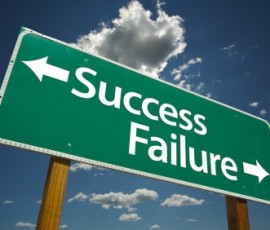 “If you build it, they will come.” This is the voice that Ray Kinsella continually hears in his Iowa cornfield in the classic film Field of Dreams. This popular quote has seethed into our consciousness and many take it to heart.
“If you build it, they will come.” This is the voice that Ray Kinsella continually hears in his Iowa cornfield in the classic film Field of Dreams. This popular quote has seethed into our consciousness and many take it to heart.
In business, we all know that Ray Kinsella’s decision to cut down his profitable cornfields on the spur of the moment was very risky. What was left out of Ray’s decision was a plan.
Businesses often take part in a strategic planning process. But more often than not, many are left puzzled as to why, after so much thought and planning, their strategies fail.
Fortune magazine claimed 10% of all business strategies are successfully implemented. Management guru Tom Peters referred to that 10% figure as being “widely inflated!”
 In the book, The Rise and Fall of Strategic Planning, author Henry Mintzberg refers to a poll of consultants conducted by Walter Kiechel of Fortune magazine that claimed 10% of all business strategies are successfully implemented. Management guru Tom Peters referred to that 10% figure as being “widely inflated!”
In the book, The Rise and Fall of Strategic Planning, author Henry Mintzberg refers to a poll of consultants conducted by Walter Kiechel of Fortune magazine that claimed 10% of all business strategies are successfully implemented. Management guru Tom Peters referred to that 10% figure as being “widely inflated!”
What is going on? Why do 90% of all strategies fail? The literature on Strategic Planning illustrates, and I agree, that the Top Four Reasons Strategies Fail is because:
- There is much confusion about what “strategy” really means.
- The typical strategic planning process focuses more on the development of the strategic plan and less on its execution (i.e. the business plan). In fact, a 1999 Fortune magazine story suggested that 70 % of all CEO failures came not as a result of poor strategy planning, but were the result of poor strategy execution. 16 years later not much has changed.
- The barriers to strategy execution have not been identified and properly dealt with.
- Most organizations do not have a clear succinct strategy document.
Reason #1: There is much confusion about what “strategy” really means.
According to Boris Yavitz & William H. Newman, in the book Strategy in Action: The Execution, Politics, and Payoff of Business Planning, the word “strategy” means different things to different people.
Our work and discussions about strategy with many executives of for-profit and non-profit organizations support Yavitz and Newman’s observation and have revealed to us several more sources of confusion.
The nature and definition of strategy becomes clearer if we talk about what strategy is not. Again, according to Yavitz and Newman:
- Strategy is not a response to short-term fluctuations in operations or the environment, nor is it the response to frequent short-term reports on the status of the business. Instead, strategy deals with the pre-determined choices, direction, focus and or/priorities toward leveraging how your business Creates, Delivers, and Captures Value.
- Strategy is not a set of numbers projected out into the future. Rather, the emphasis is on the quality and direction of the organization. How you Create, Deliver and Capture Value are the kinds of issues that are molded into a verbal statement of the direction your organization hopes to move.
- Strategy is not a projection of what you did last year or of what appeared in last year’s budget. This needs no explanation.
- Strategy is not a functional plan or checklist of priority actions, not even a long-term plan such as a five-year marketing plan should be considered your strategy. Rather, strategy provides the framework for the balanced development and integration of all the functional plans (marketing, financial, HR, operations, etc.) an organization carries out day to day to Create, Deliver and Capture Value. It is the strategy that determines the functional plan priorities and not the organization’s product, service or project of the day.
- Strategy is not a statement of good intentions or optimistic wishes. Merely envisioning a future world and selecting an attractive position in that world is not a strategy. Taking into consideration the external and internal environment is important. Strategy is based on an analysis of the interplay of the internal and external forces, which will leverage your organization’s ability to Create, Deliver and Capture Value .
- And finally, strategy is not a bunch of ideas in the minds of a few select leaders of the organization. More often than not, ideas are labeled strategies because they come from the top executives in the organization. Strategy development must involve and be understood by all key players. Unless there is widespread understanding, coupled with acceptance and firm commitment, not much progress toward strategic success will occur.
So, what does “strategy” really mean? Come back for part 2 and find out!
For the month of August, Najera Consulting Group will be conducting Free 1 Hour Strategy Sessions for a limited number of owners of small to medium sized businesses and non-profit executive directors.
Schedule Your Session Today and:
• Gain better clarity of your organization’s vision.
• Uncover hidden challenges and blind spots that could be sabotaging your success
• Leave this session renewed, inspired, and re-energized about your business or non-profit.
Space is Limited. Click here to contact us with the subject line, “Free Strategy Session” or call: 630-326-3238
 About the Author:
About the Author:
Gabriel Najera is the president & founder of the Najera Consulting Group. Gabriel is a frequent speaker to organizations. And, is a highly sought after advisor to corporate and nonprofit executives looking to develop a strategic thinking mindset.
Gabriel is the author of the forthcoming book, Lessons From the Field: From Farmworker to Fortune 500 Consultant. Gabriel is available to speak to your organization. To inquire about scheduling Gabriel for an upcoming speaking engagement or to inquire about our consulting services, please click on this link.

















I think the issue with the term strategy is the fact that it is such an open-ended word. There can be so many things associated with strategy, and different ways to go about making one, implementing it and than adapting it. Business planning, fails because strategy is not conducted correctly from start to finish – somewhere along the line some aspect sneaks in that is not a “strategic” aspect and it becomes the crutch of the plan, dooming it. This is what happens when it’s open-ended.